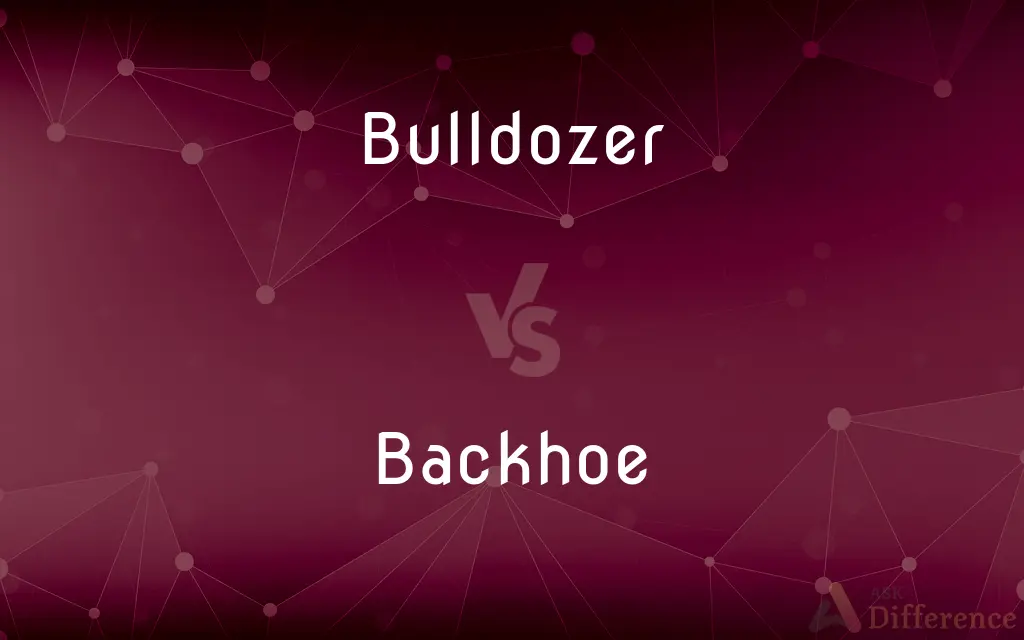Bulldozer vs. Backhoe — What's the Difference?
By Tayyaba Rehman — Updated on August 18, 2023
A bulldozer is a heavy machine with a large blade for pushing earth, while a backhoe has a digging bucket on the end of a two-part articulated arm for excavation.

Difference Between Bulldozer and Backhoe
Table of Contents
ADVERTISEMENT
Key Differences
A bulldozer is primarily designed for pushing and moving large quantities of soil, rubble, or other materials. On the other hand, a backhoe is typically used for digging and removing dirt, with a large bucket at the end of a hinged two-part arm.
A bulldozer generally has a continuous track system, much like a tank, allowing it to traverse over challenging terrains with stability. In contrast, a backhoe usually sits on wheels and may resemble a tractor but with the addition of the digging arm at the rear and sometimes a loader bucket at the front.
Bulldozers are often used in land clearing, grading, and in some mining operations. Meanwhile, backhoes are vital for tasks that require precise digging like trenching for utilities, breaking asphalt, or creating foundations for buildings.
In terms of attachments and versatility, backhoes have a slight edge. While bulldozers primarily use their front blade, backhoes can have various attachments fitted to their rear arm, such as breakers, augers, or grapples. This makes the backhoe a more adaptable machine for varied tasks, whereas bulldozers excel in tasks that require raw pushing power.
Comparison Chart
Primary Function
Pushing earth and materials
Digging and excavation
ADVERTISEMENT
Design Feature
Large, flat blade in front
Digging bucket on a two-part articulated arm
Mobility
Continuous track system
Typically on wheels
Typical Use
Land clearing, grading
Trenching, breaking asphalt, foundations
Attachment Versatility
Limited to front blade
Multiple attachments possible for varied tasks
Compare with Definitions
Bulldozer
A vehicle used for leveling ground or removing obstructions.
The park required a bulldozer to prepare the area for a playground.
Backhoe
A hydraulic excavator with a bucket attachment.
They rented a backhoe to install the swimming pool.
Bulldozer
A strong, forceful person who intimidates or pressures others.
He was the bulldozer of the group, always getting his way.
Backhoe
A versatile piece of construction equipment with a digging arm at the rear.
The backhoe quickly dug a trench along the property line.
Bulldozer
A large, powerful tractor equipped with a broad vertical blade.
The construction team used a bulldozer to clear the land.
Backhoe
A machine for digging and excavating with a bucket on a two-part arm.
The crew brought in a backhoe to start the foundation work.
Bulldozer
A machine for pushing or dragging earth or other materials.
The bulldozer moved the debris out of the construction site.
Backhoe
A device for heavy-duty digging tasks in construction sites.
With a backhoe on site, the excavation was completed in no time.
Bulldozer
A bulldozer or dozer (also called a crawler) is a large, motorized machine that travels on continuous tracks or large tires and is equipped with a metal blade to the front for pushing material: soil, sand, snow, rubble, or rock during construction or conversion work. When needed, a hook-like device (termed a ripper) can be mounted on the rear to loosen dense materials.
Backhoe
A tractor-like machine with a loader at the front and a digging mechanism at the back.
The backhoe was essential for the road repair job.
Bulldozer
A powerful track-laying tractor with caterpillar tracks and a broad curved upright blade at the front for clearing ground.
Backhoe
A backhoe—also called rear actor or back actor—is a type of excavating equipment, or digger, consisting of a digging bucket on the end of a two-part articulated arm. It is typically mounted on the back of a tractor or front loader, the latter forming a "backhoe loader" (a US term, but known as a "JCB" in Ireland and the UK).
Bulldozer
A heavy, driver-operated machine for clearing and grading land, usually having continuous treads and a broad hydraulic blade in front.
Backhoe
A mechanical excavator whose bucket is attached by a hinge to a two-part arm and is drawn backward to the machine when in operation.
Bulldozer
An overbearing person; a bully.
Backhoe
A piece of excavating equipment consisting of a digging bucket or scoop on the end of an articulated arm, drawn backwards to move earth. Used in excavator/digger and backhoe tractors.
Bulldozer
A tractor with an attached blade for pushing earth and building debris for coarse preliminary surface grading, demolishing building structures, etc.
Backhoe
A multi-purpose tractor with a front-mounted loading bucket and a rear-mounted digging bucket. The tractor combines a front-end loader/loader and an excavator/digger.
Bulldozer
One who bulldozes.
Backhoe
To excavate using such equipment.
Bulldozer
A member of a self-identified group of white US Southerners who colluded to influence outcomes of post-Reconstruction elections by intimidating, coercing and bullying black voters and legislators, including burning down houses and churches, flogging and murdering opponents.
Backhoe
An excavator whose shovel bucket is attached to a hinged boom and is drawn backward to move earth
Bulldozer
(by extension) A bully; an overbearing individual.
Bulldozer
To bulldoze (push through forcefully).
They bulldozered through the crowd.
Bulldozer
One who bulldozes.
Bulldozer
Large powerful tractor; a large blade in front flattens areas of ground
Bulldozer
A mechanism or tool that flattens or pushes aside.
The bulldozer made quick work of the large mound of sand.
Common Curiosities
How is a backhoe different from a bulldozer in terms of function?
A backhoe is mainly used for digging and excavation, whereas a bulldozer focuses on pushing materials.
What is the main advantage of using a backhoe in construction?
The backhoe's versatility, owing to its multiple attachments, makes it suitable for a range of tasks from digging to lifting or breaking.
What is the primary function of a bulldozer?
A bulldozer is primarily used for pushing and moving large quantities of material like soil or rubble.
Can you fit a digging arm to a bulldozer?
Typically, no. Bulldozers are designed primarily for pushing, while backhoes are designed for digging.
Why do bulldozers often have a continuous track system?
The continuous track system provides bulldozers with stability and traction, especially in rough terrains or soft ground.
Can a bulldozer be used for digging tasks?
While a bulldozer's main function is pushing, some specialized bulldozers can be equipped for digging, but they are not as efficient in digging as backhoes.
Are backhoes only used for digging purposes?
No, backhoes can be used for various tasks like lifting, breaking, and even pushing, depending on the attachment used.
What kind of projects would ideally require a bulldozer?
Projects involving land clearing, leveling, or moving large amounts of material in a short distance would benefit from a bulldozer.
Which equipment, bulldozer or backhoe, offers more attachment versatility?
The backhoe offers more attachment versatility compared to the bulldozer.
How is the mobility of a backhoe compared to a bulldozer?
Backhoes usually sit on wheels, offering better mobility on roads, while bulldozers with track systems are more stable on uneven terrains.
Share Your Discovery

Previous Comparison
Mattock vs. Pickaxe
Next Comparison
Uncontactable vs. ContactableAuthor Spotlight
Written by
Tayyaba RehmanTayyaba Rehman is a distinguished writer, currently serving as a primary contributor to askdifference.com. As a researcher in semantics and etymology, Tayyaba's passion for the complexity of languages and their distinctions has found a perfect home on the platform. Tayyaba delves into the intricacies of language, distinguishing between commonly confused words and phrases, thereby providing clarity for readers worldwide.
















































